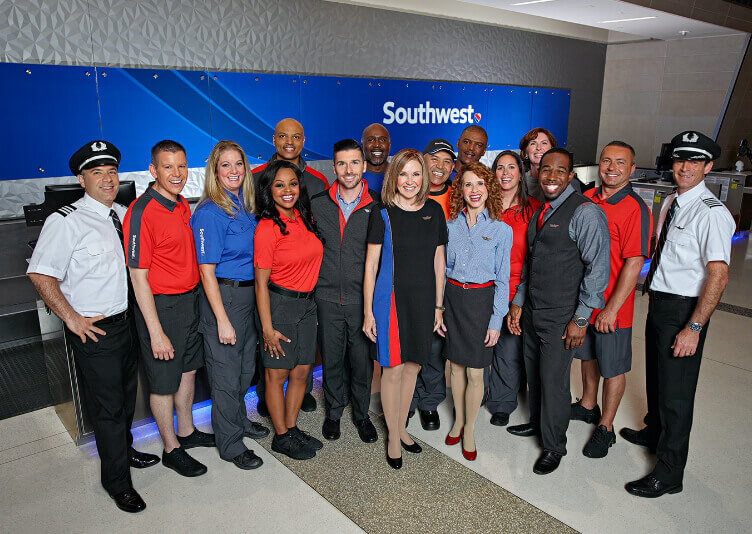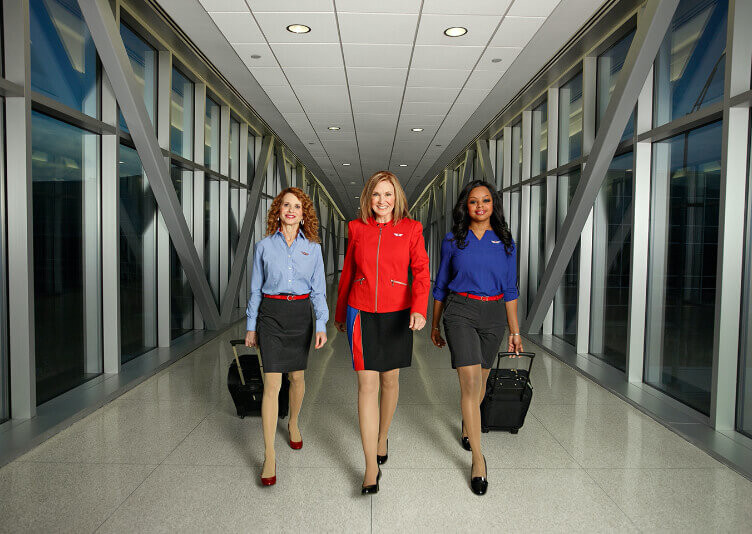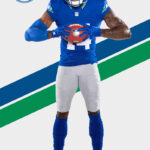The visual identity of Southwest Airlines was undergoing a significant transformation, signaling the need for a uniform refresh that would embody the company’s evolving and vibrant brand. Leadership recognized the opportunity to create flight attendant uniforms that not only looked fashionable but also resonated with the airline’s core values and, most importantly, its employees.
The existing uniforms, introduced in 1996, had successfully communicated a message of comfort and approachability. The soft-collared polos and casual pants projected an image of an “unstuffy” airline, where both employees and customers could feel relaxed. However, as the brand evolved, there was a desire to amplify this message while injecting a sense of modern style and renewed employee pride into the Southwest Airlines Flight Attendant Uniforms and the broader employee dress code.
Spearheading this ambitious uniform upgrade was Sonya Lacore, Vice President of Inflight Operations and a former Flight Attendant herself. Her vision was to create a powerful new visual statement, but she set only one firm parameter: Southwest employees would be at the heart of the design process. Employee input would be paramount in shaping the look, feel, and functionality of their own uniforms.
“When you’re actively performing your duties—stretching, bending, lifting, and everything in between—there can sometimes be a disconnect between aesthetic appeal and practical comfort,” Sonya explained. “However, I truly believed that we could achieve both. And I knew that the only path to success was through the genuine engagement of our frontline employees.”
This commitment to a democratic, employee-centric approach was met with resistance from some initial design agencies. They were also hesitant about designing uniforms intended for longevity, rather than fleeting seasonal trends. Undeterred, Southwest reaffirmed its dedication to employee involvement. The company’s stance was clear: We have our own designers, and they are our Employees.
From this point, progress was swift. Southwest partnered with a suitable agency and assembled a diverse design team of 43 employees. Representing various departments, body types, ethnicities, genders, and personal styles, this team ensured that the new Southwest Airlines flight attendant uniforms would be truly representative of the entire employee population.

Ensuring versatility across diverse roles within the Southwest family was a key challenge in designing the new flight attendant uniforms.
The design team embarked on an inspirational research trip to Chicago, exploring various retail stores to gather ideas and inspiration. This was followed by lively and passionate discussions, where the merits and drawbacks of different design concepts were meticulously analyzed.
Southwest aimed for variety, ensuring employees weren’t restricted to a single uniform style. All ideas regarding styles, cuts, and colors were open for consideration. Bow ties? The general consensus was “not really our style, especially for those of us working on the ground.” Shorts? Keep them, but redesign them for a sportier feel. Color schemes? Charcoals and blacks were strong contenders, alongside richer primary colors.
Through numerous meetings, the team refined their vision, arriving at a core set of guiding principles – a consensus on the desired image. These guidelines were articulated as: Professional, but not overly formal. Fun, but not gimmicky. Casual, but not sloppy.
Guided by these principles, a striking new uniform collection began to take shape. The range included shorts, pants, polos, blouses, skirts, and two dress styles, eventually expanding to 75 mix-and-match pieces. However, the most impactful element was the chosen color palette and design. Blues and reds, inspired by Southwest’s aircraft liveries, were incorporated as sleek stripes along dress hemlines and polo shoulders, injecting a vibrant yet sophisticated brand identity into the Southwest Airlines flight attendant uniforms.
The years 2015 and 2016 were dedicated to meticulous development. Once fabrics were selected, Southwest dispatched team members to overseas factories to rigorously ensure ethical labor practices and alignment with the company’s values. Early uniform prototypes were then distributed to 130 employees for real-world wear-testing and feedback.

The new Southwest Airlines flight attendant uniforms, with their bold accents and familiar brand colors, perfectly embody the spirit of Southwest.
“We conducted extensive wear-testing to guarantee comfort and functionality across all workgroups,” noted Flight Attendant Tracye Tipps, a member of the design team.
Sonya and her team sought comprehensive feedback. Did colors fade after washing? How did the uniforms perform in varying temperatures? Were stains easily removable? Some pieces excelled, while others, despite looking good on paper, didn’t translate as well into practical wear.
By early 2016, Sonya and her team knew they had achieved their goal. They organized a fashion show in Dallas for Chairman and CEO Gary Kelly and other Southwest leaders. Complete with a red carpet, upbeat music, and an atmosphere of excitement, the event showcased the culmination of their efforts.
Initial nerves quickly dissipated as design team members took to the runway. Leadership erupted in applause and cheers, expressing genuine pride in the employee-designed uniforms.
One model, a Southwest mechanic who had initially been hesitant, approached Sonya after the event, tears in her eyes. “I can’t believe it,” she said. “I never imagined I would ever walk a red carpet.”
In June 2017, when Southwest employees officially began wearing the new uniforms, a wave of pride resonated throughout the entire company. After three years of dedicated work, it was clear: from every hemline to neckline, these uniforms were authentically Southwest. Approachable yet professional, comfortable yet chic, striking and personable – the new Southwest Airlines flight attendant uniforms perfectly captured the airline’s essence.
These uniforms were not designed for fleeting trends or external perceptions, but to instill pride in the People of Southwest, enhancing how they felt and presented themselves each day.
“Looking back, I realized the profound impact of uniforms,” Sonya reflected. “I understood their importance, but I was unaware of how important. When employees look good, they feel good. And that feeling is incredibly powerful.”

